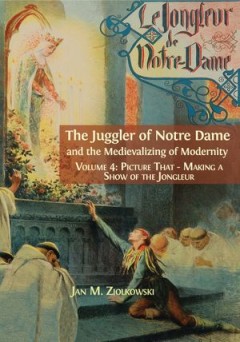Filter by

The Juggler of Notre Dame and the Medievalizing of Modernity: Volume 4 Pictu…
Born into a distinguished aristocratic family of the old Habsburg Empire, Hermynia Zur Mühlen spent much of her childhood and early youth travelling in Europe and North Africa with her diplomat father. Never comfortable with the traditional roles women were expected to play, she broke as a young adult both with her family and, after five years on his estate in the old Czarist Russia, with her …
- Edition
- -
- ISBN/ISSN
- 9781783745319
- Collation
- -
- Series Title
- -
- Call Number
- -

Mao Zedong’s “Talks at the Yan’an Conference on Literature and Art: A T…
The writings of Mao Zedong have been circulated throughout the world more widely, perhaps, than those of any other single person this century. The “Talks at the Yan’an Conference on Literature and Art” has occupied a prominent position among his many works and has been the subject of intense scrutiny both within and outside China. This text has undoubted importance to modern Chinese liter…
- Edition
- -
- ISBN/ISSN
- 9780472901333
- Collation
- -
- Series Title
- -
- Call Number
- 700 MAO m

Arbeits(un)fähigkeit herstellen
As most industrialised countries, Switzerland is increasingly attempting to (re)integrate people with health restrictions and disabilities into the job market. The reinforced political demand to reintegrate people with health restrictions challenges both the involved organisations and its employees. While the means and methods to assess (in)capacity for work are more and more refined, the accor…
- Edition
- -
- ISBN/ISSN
- 9783037777237
- Collation
- -
- Series Title
- -
- Call Number
- 300

The Juggler of Notre Dame and the Medievalizing of Modernity: Volume 3 The A…
This ambitious and vivid study in six volumes explores the journey of a single, electrifying story, from its first incarnation in a medieval French poem through its prolific rebirth in the nineteenth and twentieth centuries. The Juggler of Notre Dame tells how an entertainer abandons the world to join a monastery, but is suspected of blasphemy after dancing his devotion before a statue of the M…
- Edition
- -
- ISBN/ISSN
- 9781783745234
- Collation
- -
- Series Title
- -
- Call Number
- -

The Juggler of Notre Dame and the Medievalizing of Modernity: Volume 2 Medie…
"This ambitious and vivid study in six volumes explores the journey of a single, electrifying story, from its first incarnation in a medieval French poem through its prolific rebirth in the nineteenth and twentieth centuries. The Juggler of Notre Dame tells how an entertainer abandons the world to join a monastery, but is suspected of blasphemy after dancing his devotion before a statue of the …
- Edition
- -
- ISBN/ISSN
- 9781783745081
- Collation
- -
- Series Title
- -
- Call Number
- -

The Juggler of Notre Dame and the Medievalizing of Modernity: Volume 1 The M…
"This ambitious and vivid study in six volumes explores the journey of a single, electrifying story, from its first incarnation in a medieval French poem through its prolific rebirth in the nineteenth and twentieth centuries. The Juggler of Notre Dame tells how an entertainer abandons the world to join a monastery, but is suspected of blasphemy after dancing his devotion before a statue of the …
- Edition
- -
- ISBN/ISSN
- 9781783744350
- Collation
- -
- Series Title
- -
- Call Number
- -

Things that travelled-Mediterranean Glass in the First Millennium CE
Recent research has demonstrated that, in the Roman, Late Antique, Early Islamic and Medieval worlds, glass was traded over long distances, from the Eastern Mediterranean, mainly Egypt and Israel, to Northern Africa, the Western Mediterranean and Northern Europe. Things that Travelled, a collaboration between the UCL Early Glass Technology Research Network, the Association for the History of Gl…
- Edition
- -
- ISBN/ISSN
- 9781787351172
- Collation
- -
- Series Title
- -
- Call Number
- -

From Sovereignty to Solidarity Rethinking Human Migration
From Sovereignty to Solidarity seeks to re-imagine human mobility in ways that are de-linked from national sovereignty. Using examples from around the world, the author examines contemporary practices of solidarity to illustrate what such a conceptualization of human mobility looks like. He suggests that urban and local scales, rather than the national scale, is a better way to frame human migr…
- Edition
- -
- ISBN/ISSN
- -
- Collation
- -
- Series Title
- -
- Call Number
- -

From Seascapes of Extinction to Seascapes of Confidence
From Seascapes of extinction to seascapes of confidence. Territorial Use Rights in Fisheries in Chile: El Quisco and Puerto Oscuro by Gloria Gallardo Fernandés is an important contribution to our understanding of the multifaceted challenges underlying sustainable solutions to ecological fisheries, the book describes how, in Chile, indiscriminate harvest of the edible shellfish Concholepas co…
- Edition
- -
- ISBN/ISSN
- 9781315159829
- Collation
- -
- Series Title
- -
- Call Number
- -

Rhetorics of Nordic democracy
Democracy is today a concept that is overwhelmingly positively evaluated almost everywhere. A lot has been written about socio-economic and cultural backgrounds of democratic regimes as well as their institutional settings. By contrast, not much is known about the political manoeuvres and speech acts by which 'democracy' has been tied to particular regions and cultures in concrete historical si…
- Edition
- -
- ISBN/ISSN
- 9789522222282
- Collation
- -
- Series Title
- -
- Call Number
- 321.8 RHE r
 Computer Science, Information & General Works
Computer Science, Information & General Works  Philosophy & Psychology
Philosophy & Psychology  Religion
Religion  Social Sciences
Social Sciences  Language
Language  Pure Science
Pure Science  Applied Sciences
Applied Sciences  Art & Recreation
Art & Recreation  Literature
Literature  History & Geography
History & Geography